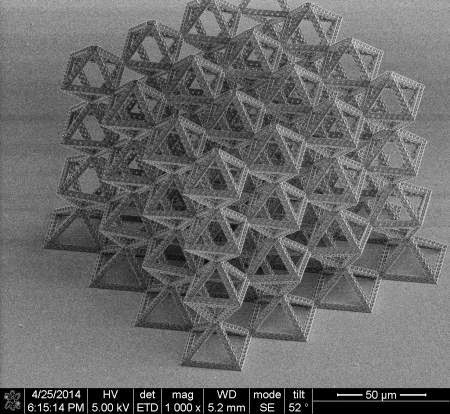| Online: | |
| Visits: | |
| Stories: |

| Story Views | |
| Now: | |
| Last Hour: | |
| Last 24 Hours: | |
| Total: | |
Nanotruss for super lightweight and superstrong material are also very useful for catalysis
Julia Greer, professor of materials science and mechanics, has made more progess with the fractal nanotruss—nano because the structures are made up of members that are as thin as five nanometers (five billionths of a meter); truss because they are carefully architected structures that might one day be used in structural engineering materials.
Greer's group has developed a three-step process for building such complex structures very precisely. They first use a direct laser writing method called two-photon lithography to “write” a three-dimensional pattern in a polymer, allowing a laser beam to crosslink and harden the polymer wherever it is focused. At the end of the patterning step, the parts of the polymer that were exposed to the laser remain intact while the rest is dissolved away, revealing a three-dimensional scaffold. Next, the scientists coat the polymer scaffold with a continuous, very thin layer of a material—it can be a ceramic, metal, metallic glass, semiconductor, “just about anything,” Greer says. In this case, they used alumina, or aluminum oxide, which is a brittle ceramic, to coat the scaffold. In the final step they etch out the polymer from within the structure, leaving a hollow architecture.
“Having full control over the architecture gives us the ability to tune material properties to what was previously unattainable with conventional monolithic materials or with foams,” says Greer. “For example, we can decouple strength from density and make materials that are both strong (and tough) as well as extremely lightweight. These structures can contain nearly 99 percent air yet can also be as strong as steel. Designing them into fractals allows us to incorporate hierarchical design into material architecture, which promises to have further beneficial properties.”
Strong and stiff and materials comprised of mostly air are well on their way to commercialization. In this World Economic Forum Discussion, Caltech materials scientist Julia Greer talks about their use in “hierarchal design,” and the impact it will have on increased efficiency and the prominence of solar cells.
The catalytic properties of materials depend strongly on their microscopic structure, with the atomic-level chemistry and structure directly influencing the activity and durability of the catalyst. However, these microscopic properties can be difficult to understand and control. Furthermore, most efficient catalysts contain substantial amounts of precious metals, rendering them prohibitively expensive. The search for efficient, inexpensive catalysts has, therefore, been challenging. On page 1339 of this issue, Chen et al. report the synthesis of a new class of electrocatalysts built from platinum-nickel nanocrystals. Their Pt3Ni nanoframes have more than 22 times the catalytic activity of conventional platinum/carbon catalysts at 0.9 V, yet contain about 85% less precious metal.
Source: http://nextbigfuture.com/2014/06/nanotruss-for-super-lightweight-and.html




